
La Cambe is a Second World War German military war grave cemetery, located close to the American landing beach of Omaha, and 25.5 km (15.8 mi) north west of Bayeux in Normandy, France. It is the largest German war cemetery in Normandy and contains the remains of over 21,200 German military personnel. Initially, American and German dead were buried in adjacent fields but American dead were later disinterred and either returned to the US or re-interred at the Normandy American Cemetery and Memorial, 15 km (9.3 mi) away. After the war over 12,000 German dead were moved from approximately 1,400 field burials across Normandy to La Cambe. The cemetery is maintained and managed by the voluntary German War Graves Commission.

Vladslo German war cemetery is about three kilometres north east of Vladslo, near Diksmuide, Belgium. Established during World War I, the cemetery originally held 3,233 wartime burials. In 1956, burials from many smaller surrounding cemeteries were concentrated in Vladslo, and it now contains the remains of 25,644 soldiers. Each stone bears the name of twenty soldiers, with just their name, rank, and date of death specified.

A war grave is a burial place for members of the armed forces or civilians who died during military campaigns or operations.

The German war cemetery of Langemark is near the village of Langemark, part of the municipality of Langemark-Poelkapelle, in the Belgian province of West Flanders. More than 44,000 soldiers are buried here. The village was the scene of the first poison gas attacks by the Imperial German Army in the Western Front, marking the beginning of the Second Battle of Ypres in April 1915.

Orglandes War Cemetery is a German World War II cemetery in Normandy, France. It is located on the northern edge of the village of Orglandes, about 30 km (19 mi) south east of Cherbourg and 7 km (4.3 mi) west of Sainte-Mère-Église on the Cotentin Peninsula. The burials come from summer 1944, immediately following D-Day and the Battle of Normandy. It is the second smallest of the six German war cemeteries in Normandy with a little over 10,000 burials. The cemetery is maintained and managed by the voluntary German War Graves Commission.
The German War Graves Commission is responsible for the maintenance and upkeep of German war graves in Europe and North Africa. Its objectives are acquisition, maintenance and care of German war graves; tending to next of kin; youth and educational work; and preservation of the memory to the sacrifices of war and despotism. Former head of the Bundeswehr Wolfgang Schneiderhan was elected President of the organisation in 2016, succeeding SPD politician Markus Meckel. The President of Germany, currently Frank-Walter Steinmeier (SPD), is the organisation's patron.

The Neuville-St Vaast German War Cemetery is a World War I cemetery located near Neuville-Saint-Vaast, a small village, near Arras, Pas-de-Calais, in Northern France. It is the largest German cemetery in France, containing 44,833 burials, of which 8,040 were never identified.
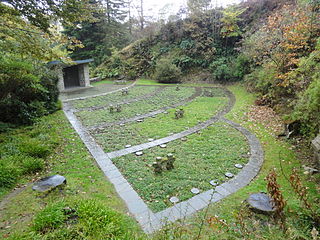
The Glencree German War Cemetery is located in the valley of Glencree, County Wicklow, Ireland.
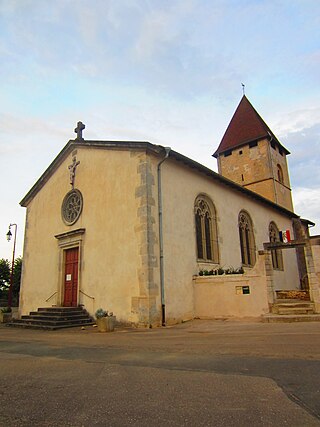
Andilly is a commune in the Meurthe-et-Moselle department in northeastern France.

The Menen German war cemetery is a military cemetery in the Belgian town of Menen territory and partly in Wevelgem. There were nearly 48,000 German soldiers buried from the First World War, making it the largest in Flanders. In between are several crosses and oak and chestnut trees. In the center is an octagonal memorial chapel.
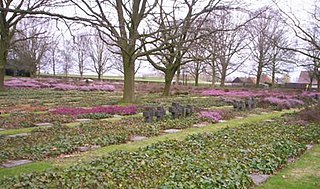
The Hooglede German war cemetery is a military cemetery in the Belgian town of Hooglede, six kilometer northwest of Roeselare. It is located at the east side of Hooglede. It contains 8,241 buried German soldiers from World War I.

The Golm War Cemetery is a World War II cemetery near the village of Kamminke close to the German-Polish border on the island of Usedom maintained and managed by the German War Graves Commission. The cemetery is the largest war cemetery in Mecklenburg-Vorpommern and one of the largest in Germany.
During World War II, the Netherlands was the scene of five years of continuous air warfare between the Allied and the Nazis as the Netherlands lies en route from England to Germany and was designated and built up as the foremost line of Nazi air defence of Germany. Also, in 1944 there was heavy land fighting during the largest Allied airborne attack of the WWII in the south and east of the country in 1944–45. Thousands of airmen, soldiers and others of many nations were killed, and their war graves in some 4,000 locations are in the care of the Dutch War Cemetery Organisation.

Sologubovka Cemetery is a German war cemetery and the final resting place of over 30,000 German war dead from World War II. Located 70 kilometres (43 mi) southeast of St. Petersburg in northwestern Russia, it has a capacity for a further 50,000 burials of previously lost German war dead.

Recogne German war cemetery is located in the hamlet of Recogne near the municipality of Bastogne, Belgium. It contains the graves of 6,807 German soldiers of the Second World War. The cemetery is situated to the east of the hamlet, and to the south of the road to Foy. It is maintained by the German War Graves Commission.

Ysselsteyn is a village in the municipality of Venray in Limburg, Netherlands. It was established in 1921 and named after its designer, Hendrik Albert van IJsselsteyn, then Minister of Agriculture. Ysselsteyn has an extensive hog raising industry.

Champigny-Saint-André is a German World War II cemetery in Normandy, France. It is located 5 kilometers South of the village of Saint-André-de-l'Eure, about 25 km (16 mi) south east of Évreux. The burials come from the summer of 1944, as the Allies pushed out of Normandy towards Paris. It is the second largest of the six German war cemeteries in Normandy with a nearly 20,000 burials. The cemetery is maintained and managed by the voluntary German War Graves Commission.

Mont-de-Huisnes German war cemetery is a military war grave mausoleum, located 1 km north of Huisnes-sur-Mer and a few kilometres southwest of Avranches, France. It presently contains in nearly 12,000 burials of German military personnel of World War II, plus some women and children. It is maintained and managed by the German War Graves Commission.
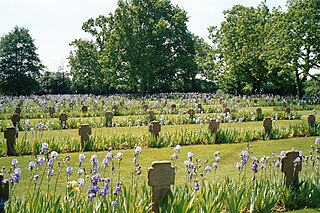
Saint-Désir-de-Lisieux is a Second World War German military war grave cemetery, located close to the village of Saint-Désir and 4 km (2.5 mi) west of Lisieux in the Calvados department, Normandy, France. It is located adjacent to the British Saint-Désir War Cemetery and is unique as the two burial grounds are linked by a pathway. It is the smallest German war cemetery in Normandy and contains the remains of 3,735 German military personnel. The cemetery was created by the British Graves Registration Commission in August 1944 with British and German casualties buried in adjacent fields.
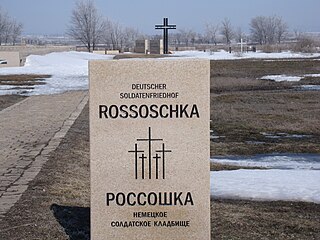
The Rossoschka German War Cemetery is located 37 kilometers northwest of the city center of Volgograd on the Rossoschka River. It is a resting place and a place of remembrance for those who died in the Battle of Stalingrad and for those missing whose bodies could not be recovered. The Rossoshka Soviet War Cemetery is also located nearby and contains Russian burials from the same battle.
























